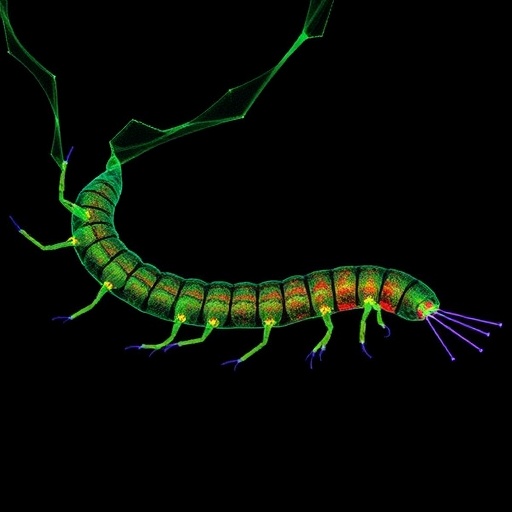In a groundbreaking study that promises to illuminate our understanding of sensory systems in organisms, researchers have unveiled critical findings regarding the role of the vab-1/Eph receptor and its associated ephrins, efn-1 and efn-4, in the assembly and functioning of chemosensory and thermosensory circuits in Caenorhabditis elegans. This worm, often used as a model organism, has demonstrated impressive utility in uncovering the intricacies of neural circuitry and behavior. The study, published in BMC Neuroscience, emphasizes the vital connection between receptor signaling and sensory perception, setting a new precedent in neuronal research.
The vab-1 gene codes for an Eph receptor, a subtype of receptor tyrosine kinases involved in a variety of developmental processes, including cell positioning and intercellular communication. Eph receptors and their ephrin ligands are pivotal in crafting not just the architecture of neural networks but also their functional capacities. The research team led by Kalichamy and their colleagues have meticulously detailed how these interactions manifest at the molecular level in C. elegans, enriching our understanding of developmental neurobiology.
One of the most compelling aspects of this study is its exploration of the role of ephrins, specifically efn-1 and efn-4. Ephrins function as the ligands for Eph receptors and have been linked to various physiological outcomes. Their role in sensory neuron development suggests a broader applicability of this molecular framework in different species, including humans. The findings point to the dual functionalities these proteins possess not merely in cellular localization but also in sensory processing, thereby shedding light on the conservation of these mechanisms across species.
The research team employed comprehensive genetic and molecular approaches to decipher the roles of the vab-1/Eph receptor alongside the ephrins during embryonic and post-embryonic development. Through knockout experiments that disabled these genes in C. elegans, they observed significant defects in the organism’s ability to process sensory inputs. The results indicate that the disruption of this signaling pathway drastically impairs the structural integrity of sensory circuits, thereby affecting chemosensory and thermosensory functions.
Moreover, the meticulous phenotypic analyses conducted in this study have illuminated the consequences of these genetic manipulations on behavior, demonstrating that C. elegans lacking functional vab-1 or its ephrins displayed altered responses to environmental stimuli, such as changes in temperature and chemical cues. These impairments provide a clear link between molecular signaling at the cellular level and behavioral outcomes, reinforcing the significance of receptor-ligand interactions in sensory processing.
Understanding the integrated networks of sensory circuits, particularly how disruptions in these networks lead to aberrant behavioral responses, is vital. With implications for understanding sensory-related disorders in humans, this research opens avenues for therapeutic strategies. Given that many of the molecular mechanisms remain conserved throughout evolution, findings in C. elegans could offer crucial insights into more complex organisms, bridging the gap between simple model systems and higher species.
The contemporary examination of sensory pathways in C. elegans, underpinned by advanced imaging and genetic manipulation techniques, has allowed for unprecedented insights into neurodevelopment. As the research detailed in this study highlights, the pathways involving vab-1 and its ephrins provide a paradigm demonstrating how signals orchestrate the construction of functional sensory networks essential for survival. It emphasizes that such molecular pathways may govern not only simple behaviors in C. elegans but may also apply to advanced neurobiology in humans and other animals.
With this new understanding, researchers could seek to address questions surrounding neurodevelopmental disorders, where sensory processing is often notably affected. The implications of this research extend beyond a better understanding of sensory circuits in C. elegans to potentially unraveling the complexities of sensory deficits observed in clinical settings. The emerging data anchors itself in a historical context where the understanding of sensory systems is continually evolving through model organism studies.
Ultimately, this unprecedented work underscores the potential benefits of examining simple organisms like C. elegans to address complex questions about neural development. The detailed pathways elucidated in this research pave the way for future investigations aimed at dissecting the detailed roles of other receptors and their associated ligands within various neural circuits. As we continue to probe the molecular underpinnings of sensation, this foundational research serves as a stepping stone towards a more intricate understanding of how genetic and molecular interactions shape the neural landscapes of all organisms.
The interplay between molecular pathways and behavioral responses is becoming increasingly clear, and studies such as this one contribute significantly to the body of knowledge required to navigate the complexities of neurobiology. While C. elegans may appear simple on the surface, the granular insights gleaned from this research highlight the sophistication embedded within its neuronal architecture and sensory functionality. As we advance in our exploration of these themes, the robust parallels drawn through C. elegans studies can significantly enhance the pipeline for future research endeavors in sensory neuroscience and related fields.
In summary, the revelations from Kalichamy and et al. regarding the vab-1/Eph receptor and its ephrins underscore a deeper biological narrative linking genetic expression, receptor activity, and sensory perception. As we continue to forge ahead in this field, the necessity of these fundamental studies will become increasingly apparent, laying the groundwork for the next generation of neuroscientific inquiry.
Subject of Research: The role of vab-1/Eph receptor and ephrins efn-1 and efn-4 in chemosensory and thermosensory circuit assembly and function in C. elegans.
Article Title: The vab-1/Eph receptor and ephrins efn-1 and efn-4 are required for C. elegans chemosensory and thermosensory circuit assembly and function.
Article References:
Kalichamy, K., Arnold, M., Hill, T. et al. The vab-1/Eph receptor and ephrins efn-1 and efn-4 are required for C. elegans chemosensory and thermosensory circuit assembly and function. BMC Neurosci 26, 65 (2025). https://doi.org/10.1186/s12868-025-00983-3
Image Credits: AI Generated
DOI: https://doi.org/10.1186/s12868-025-00983-3
Keywords: sensory systems, chemosensation, thermosensation, Eph receptors, C. elegans, neurodevelopment.
Tags: BMC Neuroscience publication insightsC. elegans sensory circuit assemblychemosensory system researchdevelopmental neurobiology discoveriesefn-1 ephrins roleEph receptor signaling pathwaysintercellular communication in wormsneuronal circuitry in model organismsreceptor tyrosine kinases in neurobiologysensory perception mechanismsthermosensory circuit developmentvab-1 Eph receptor function





